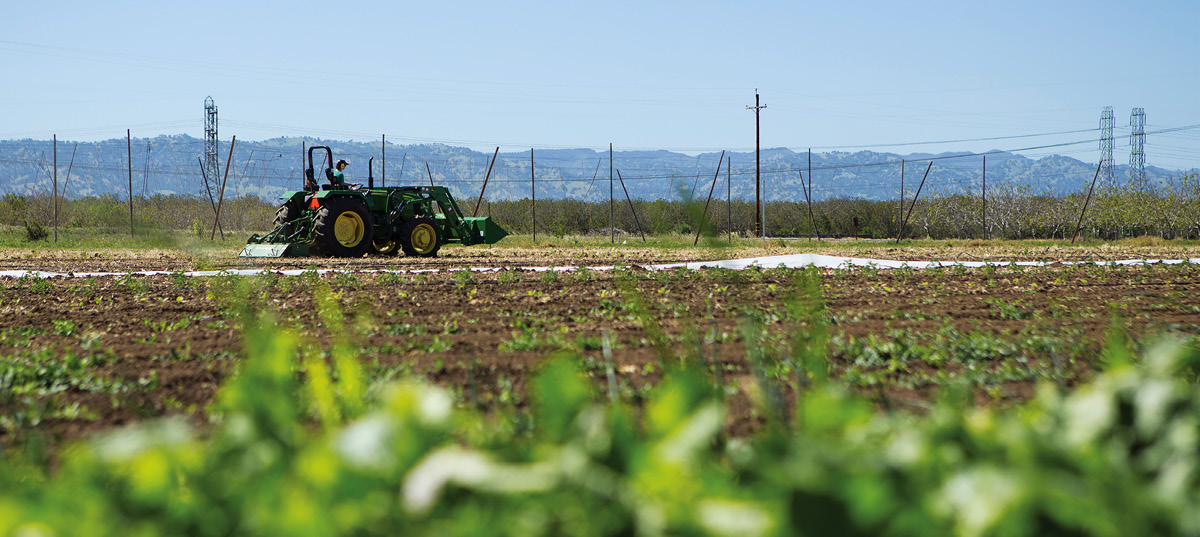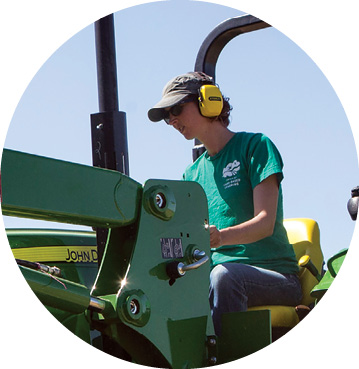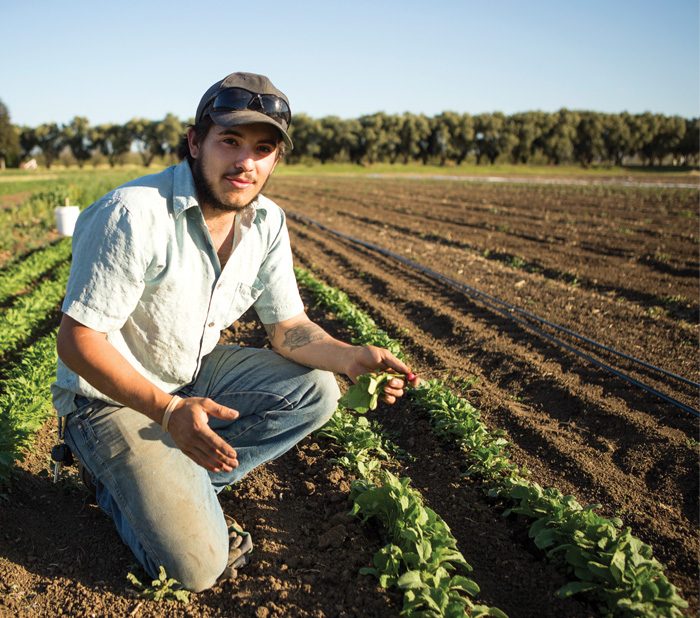Alex Gomez is a beginning farmer who grows seasonal vegetables in Winters, Calif. He leases ground through the California Farm Academy, a non-profit organization that trains farmers.
Small farms and “micro-farms” are a trend that seems to encompass everything from patio “farming” to the small acreage producer. In fact, maybe it’s not that new at all — modern large-scale producers have generations of small farms in their lineage. Today’s trend is different, however, in that USDA is tracking and funding it and consumers are seeking out local food. That’s why you need to pay attention to small farmers in your market who need equipment to grow their crops and their businesses.
Alex Gomez describes himself as a micro-farmer. He is a beginning farmer, just finishing up his first crop year. Gomez is learning how to grow produce on a small scale, just 1 acre, through the California Farm Academy, a program through the Center for Land-Based Learning (see the sidebar “Growing Farmers”). At 23, Gomez is open to the possibilities. “I’m not trying to limit myself. Right now, I’m learning and 1 acre is fine for me, but who knows? I would hope that I can make the means to have 5 acres and more in the future,” he says.
He’s using equipment provided by the academy, including a tractor that is being rented through Valley Truck & Tractor, a John Deere dealership with 9 locations in northern California. (See “Customize Programs for Small Ag” below)
Learning to Farm
Gomez’s interest in farming grew out of his interest in mechanics. He has a degree in mechatronics from Sierra College of Rocklin, Calif. He wanted to learn a trade that he could someday apply to his own small business.
While in college, he traded labor on a small vegetable farm in exchange for staying in the trailer owned by the farmer, who served on the board of the center and encouraged Gomez to check out the opportunities.
“I had always worked at mechanics’ shops and learned welding and carpentry. I’ve always had an interest in working hard. I was drawn to agriculture because it combined those types of trades as well as growing food,” Gomez says.

|
| Equipment that is versatile is an important feature for small and beginning farmers who may grow numerous crops for farmers markets, restaurants and other local customers. According to USDA’s 2012 Census of Agriculture, 11% of farms are between 1-9 acres and 28% are 10-49 acres. |
He had also previously worked at orchards where he operated tractors and attachments to maintain the grounds, giving him the equipment experience he would later need for his own operation.
“Being small, I feel like accuracy is important…”
Gomez recently completed the California Farm Academy’s 7-month program and is now testing out his own theories for growing produce organically on a small scale. Gomez took over his acre last fall from another beginning farmer who has since moved on to his own 5 acres.
“It was just bare ground and I planted a cover crop immediately. We used a John Deere 5065 E and chisel plowed the area. We didn’t have a grain drill, so I just threw out the seed and waited for rain. I put in a grass and bean mixture. It mends the soil by bringing in organic matter,” Gomez says.
Growing FarmersThe California Farm Academy is a 7-month program that provides an intensive overview of what it takes to succeed as a farmer. It’s held at the Center for Land-Based Learning headquarters in Winters, Calif. Currently, 6 farmers are leasing land through the center to take the next step in becoming a farmer — growing their own crops. “The program is based on the idea that farmers are aging and we need new farmers to take over and grow our food,” says Maureen Thompson, manager for the California Farm Academy. “Many beginning farmers don’t have family properties to take over, so they start small. When they have the capital and are comfortable with what they are doing, their operations often grow larger.” Thompson works with Valley Truck & Tractor to rent a tractor, a John Deere 5065 E. The dealership, which has 9 locations in northern California, set up a rent-to-own arrangement that fits with the academy’s budget and grant guidelines. “We needed a tractor that could be diverse and have the capability to do things like chisel plow as well as work within a 5-foot cropping system,” Thompson says. The farmers are all growing a variety of seasonal vegetables and many are marketing their products through farmers markets and restaurants. The farmers make due with a variety of older attachments that have been donated to the center and other tasks, like harvesting and packing, are done by hand. What would be on Thompson’s wish list for equipment for the farmers? A 5-foot flail mower, grain drill and disc. |
During his first off-season, Gomez started seedlings in the center’s greenhouse and by January, he was ready to prepare his plots.
Following a Season

|
| Maureen Thomson is program manager at the California Farm Academy where she oversees training for beginning farmers. She arranges for equipment for the farmers in the program to use, including this 5065 E John Deere utility tractor that is rented from Valley Truck & Tractor. |
Because of the ongoing drought in California, Gomez decided to only work up half of the acre, with the other half lying fallow throughout the summer. He uses a flail mower to limit the growth on the cover crop to conserve moisture. He disc plowed the other half and used the John Deere with a tiller attachment to smooth the soil and shape 18 beds that are each about 400 feet long. He started off transplanting by hand, using a tool he built which is similar to a tool used in reforestation. Later this summer, he started using an old transplanter attachment that was recently donated.
Gomez grows nearly a dozen different fruits and vegetables throughout the growing season. In the spring, he grows carrots, beets, spring greens, onions, turnips and radishes. Summer crops include tomatoes, peppers and melons. In the fall, he grows broccoli and cauliflower.
He uses a John Deere 900HC (high crop) tractor with a belly-mounted cultivator throughout the season to control weeds. “I’m small and I don’t have a crew to weed. The tractor is something that a lot of small organic farmers use. We’re not spraying chemicals so it helps us manage weeds. We’re constantly fighting weeds and trying to get as close to the plants as possible. I cultivate for about a month or so, then the plants are tall enough to shade out the weeds,” Gomez says.
He says it takes expertise to operate the tractor for weeding and not damage his crops. “Being small, I feel like accuracy is important. If I lose one bed that can be quite a bit of produce for me.”
Dealer Takeaways
|
Harvesting and packing is all done by hand and Gomez delivers his own produce. He sells through a farmers market on Saturdays, at the center’s farm stand on Tuesdays and to several restaurants in Sacramento. He’s trying to secure a few grocery store clients as well.
Gomez says his customers are looking for a varied selection of produce along with unusual varieties. “Restaurants are always looking for something new. I’m always watching what’s popular on the East Coast and in France. The chefs in France started using rainbow cauliflower and now it has made its way to the West Coast,” he says.
Planning for Growth
Gomez says a smaller operation like his can be risky, but it also provides some advantages, allowing him to grow specialized produce.
“Not many growers can grow heirloom tomatoes. They work for me, but on a large scale they might be hard to do,” he says, referring to the workload of staking and managing the older varieties.
He says the 5065 E is a large tractor for his current operation. However, regardless of the size of his farm, he needs reliability and flexibility. “I see the potential to finance so I can get a nice tractor that I can rely on. I have some mechanical aptitude, but I don’t want it to break down in the heat of the season. I don’t have the time to rebuild a head or diagnose an electrical problem. For me, it’s important to have something reliable,” Gomez says.
Gomez plans to lease the farm for 3 years and then he hopes to find other ground to lease and will work to secure financing for equipment. “I have a business plan and when the time comes, I’ll show them what I’ve done and we’ll see how it goes from there. It’s hard to say what my ultimate size will be, but I hope I can someday farm 5 acres,” he says. “There are so many factors for someone to figure out who hasn’t grown up in agriculture.”
Tracking Beginning FarmersThese stats and terms identify who is a farmer and who is a beginning farmer as well as the federal support of the market:
|







Post a comment
Report Abusive Comment